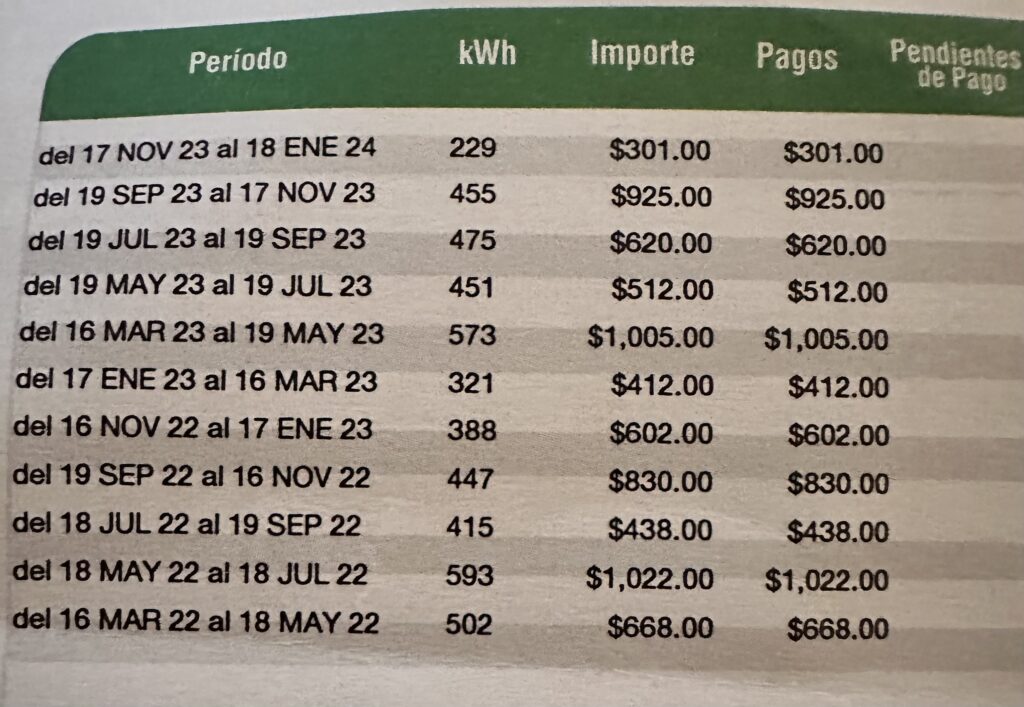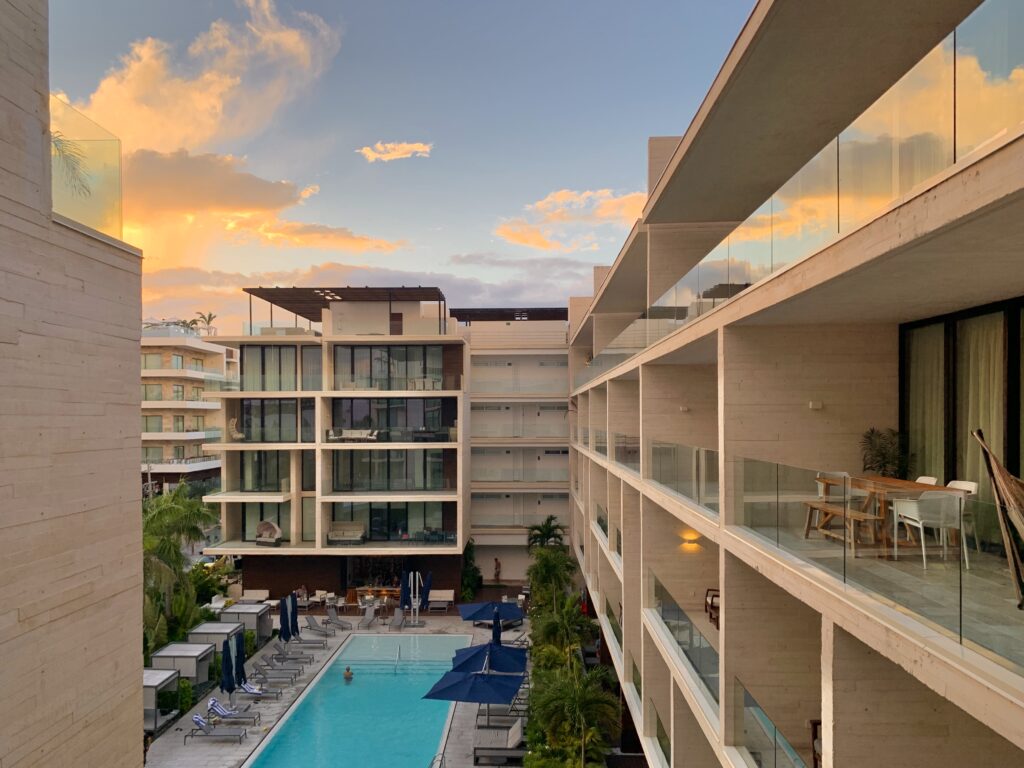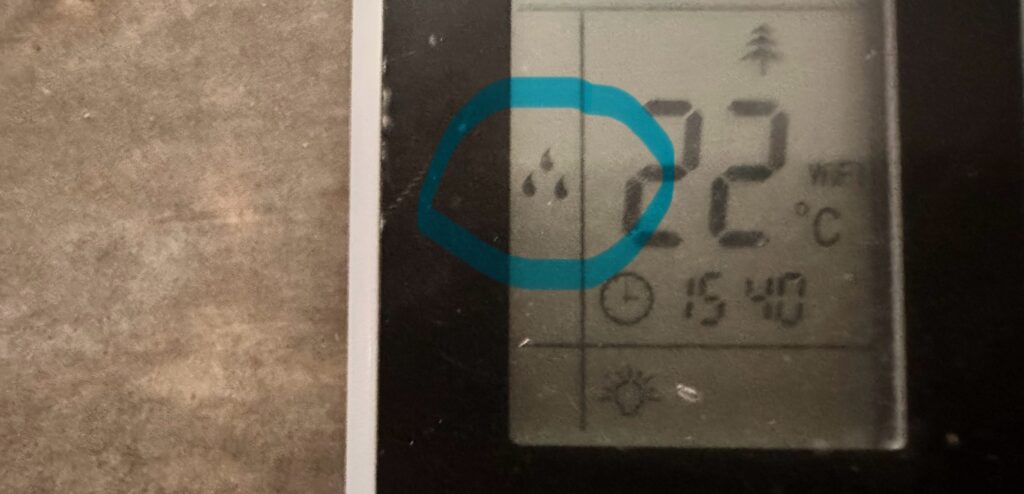
How to keep your (CFE) Electricity bill low in Mexico!
If you live in Mexico, you know the electric bill can be expensive. In fact, electric (CFE) is one of the most expensive services you will have at home. If you are an owner and have a rental property or you live in your home, you surely would like to spend less on this service. It is possible to pay much less. We can prove it! How so? We have one property that we pay on average $25 USD a month for electricity. And we want to share some tips about how to keep your energy bill low here in Mexico.
So here is a little more about the property. We don’t want you to think that this is some tiny apartment that hardly has any electrical usage. This property is a two-bedroom, two-bathroom house with square footage about that of the average American home. There are two mini split air conditioners, all led lights, and gas for cooking and hot water.

Home design
We know most people are not going to build their own homes nor have the opportunity to design what you want, but here are some tips that you can apply when looking at properties.
Good home design to save energy
- Trees, bushes and plants. This is one of the easiest ways to save on your electric bill in Mexico. When you consider each tree is equal to one air conditioner, it starts to make sense to plant more. The shade it gives cools the area around your home. Having the air cooler around your home will save you money. One wall of the house mentioned above would get full sun in the afternoons. The interior wall would be hot to the touch. After planting vines on the wall, the interior temperature was normal and reduced the heat in the room immensely! Go plants!
- Windows. Unfortunately, most windows in Mexico are very poor when it comes to insulation factors. This is one of the ways that developers save a lot of money off the cost of construction of units in Mexico. Basic windows compared to energy saving windows is about 3 to 4 times less expensive. The only thing is you will pay more in the end with basic windows. Cheap windows also let in more sound, and that is an issue in Playa Del Carmen.
- Cross breeze. Many condos in Mexico are designed to have air conditioning on most of the time. Having good windows to open and ones that create a cross breeze are the most efficient. Having two opposing walls with windows though it harder to find then it should be.
- Type of glass. There are usually 3 types of glass that reflect the heat and UV light. Basic, medium and high. The highest reflective quality looks like a mirror from the outside, so sometimes people don’t like that one. The model house mentioned above has the 50% reduction glass (medium) and it works very well.
- Fill those gaps! A big pet peeve of ours is when we are in a hotel and the door has viable light around it and a gap which you can put a finger under the door. This means that the cool air inside is leaking outside. If you take all the gaps in a house and put it together it would be like a microwave size hole in the wall letting hot air in all the time. Not only do you keep insects out, but you also keep cool air in with door sweeps and caulking gaps around windows and doors
- Ceiling heights. Most condos have ceilings at 9 ft. This is a little more than other standard buildings in other countries. The higher the ceilings, the hotter air can rise and leave fresh air below where you live.
- Balconies and awnings. Most buildings with balconies create shade part of the day and precent direct sunlight from entering your condo. This is similar to the art deco style of south Florida where windows have concrete awnings above them for shade. The same principle applies here.
- Fans and more Fans. Ceiling fans can cool a room when it is not too hot. This can save using the air conditioning. It is best if almost every room has a ceiling fan.

We don’t recommend these types of properties
- Lofts. This is a BIG pet peeve of ours. The entire concept of “hot air rises, cold air falls” is a concept hardly understood in Mexico. Lofts consist of an open space with a second level, usually the bedroom. The problem with this is the bedroom gets all the hot air rising and you need to run air conditioners all the time to keep the upper area cooler. If there is no door in the upstairs room, all the cool air falls to the lower level and you have a nonstop battle on your hands that costs you a lot!
- Corner units in the sun. It is nice to have views and more windows, but if you have a house or condo that gets sun one two or more sides during the day, you are going to be heating the walls. The exterior concrete walls absorb the heat and radiate it back inside at evening.
- Ground floor apartments. This might seem ok, but you need to check if there is a moisture problem. Often if there is no cross breeze or direct sunlight getting into the apartment, there can be humidity issues. Just one personal example, I rented a condo in Playa on the first floor of a building. It had windows on one side, but it was shaded. The place seemed fine moving into it. But after living there, I realized how bad the moisture was. Shower towels would not dry, leather belts and shoes were getting moldy, and the only solution was the run the air conditioner often. So, the moral of the story is to be careful of first floor apartments that can have moisture problems. The solutions can run up your electric bill.
- Really small condos. There are several buildings in Playa Del Carmen known for putting as many condos as possible in a footprint. Some of these condos only have windows that face the interior courtyard of the building. These small spaces are horrible when it is hot and only are livable with air conditioning. Sometimes these condos appeal to buyer because the low price and high rentability. But often these small units come at a cost, and some of it is electric.
Gas vs Electricity
Gas is popular in Mexico for homes. Gas stoves and boilers are the most common appliances that run on gas. Gas is cheaper than electric and having a mix of services has its benefits. However, you might not have a choice where you buy. It is popular in some condo buildings sold to foreigners to have 100% electric for everything.
Some builders like electric only because there are not gas lines going through the building and it makes it easier to build. Some foreigners also get nervous having gas appliances in a condo as well. So, there is a mix of places that have only electric or gas and electric services. It is best to have both services to keep your bills lower.
Energy Saving Tips for Boilers
Here are three tips for boilers and heating your water.
- Electric boilers often have a control on them where you can regulate the temperature of the water. Move the tank temperature down to the perfect temperature that you bathe in. This way, you can turn on just the hot water in the bathroom and it is already a good temperature without overheating the water and you don’t need to add cold water to the mix. Of course, with more people using the showers, everyone will have a different preferred temperature. This only works if you live at the property.
- Research Heat-on-demand boilers. These heat when you need it and don’t keep a tank of hot water waiting all day for you to use some. The technology has gotten better, but some situations where there are several people needing hot water at the same time, it might have a hard time keeping up.
- Turn your gas boiler off when not using it. If you have good access to your boiler, turning it on when you need it can save a lot of gas. Leaving the pilot light on is like leaving a burner on your stove all day. It not only adds heat to the room, but it also wastes gas. This might not work for everyone, but it is an option. Sometimes when the weather is warm, you don’t even need to turn on the boiler.
Other money saving tips on your (CFE) electric bill
- It is a convenience to have a washer and dryer in your place. However, these, especially dryers, use a lot of energy. In Mexico there are neighborhood laundry services that wash, dry, fold and bag your clothes for same day or next day service. This not only saves you time, but it also saves from buying soap, machines, water, repairs, and electricity. For two people that cost of sending out your clothes is about 200-250 pesos a week. It does take years for the machines to just break even with expenses. So, this is something to consider.
- We did mention there was no solar panels included in the property with the low electricity bill, but some solar lights outside can give you free light outside and lighten up your garden. We do NOT recommend buying cheap solar lights (like ones in Walmart). Cheap solar lights give off low light and usually do not last. You can find some decent quality solar lights at Home Depot. Most cost about 1000 pesos each. A solar light at your entrance that turns on when it is dark is a great tool to make your home look lived in, plus you have a light at night.
- Buy a temperature gun to take temperatures of surfaces. This is the same pistols that were used all during Covid. These are a good tool to check which walls and surfaces are hotter and where you need to focus attention for more energy efficiency.
- Led lights. Led technology has gotten much better. Led emits much less heat and are much more efficient. There is a little cost upfront because the cost of the bulbs, but most last 6 years and really keep your bills low.
- Run your air conditioner in low humidity mode. There are different settings on your remote for your air conditioner. There is the cool mode and then what looks like three raindrops. This is a mode to lower the humidity and cools. It saves a tone of energy and is a good mode for the nighttime when you don’t need it freezing inside, but only to keep it cooler for sleeping.



Be the first to comment